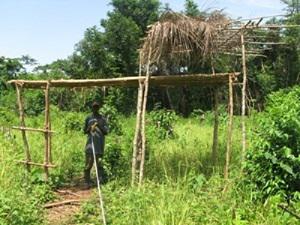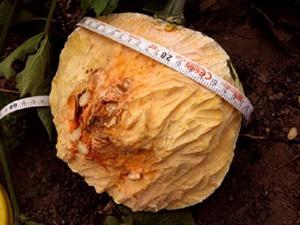Joana Vaz de Sousa
This project aims to characterize how farmers relate to landscape features, document crop damage intensity and explore social meanings of damage in case-studies in Boé and Cantanhez areas

Guarding platform.
While long-term sustainability of human and certain wildlife species coexistence is questionable, it is important not to assume that whenever they compete for resources conflict always results. However tension between rural populations and conservation entities can be exacerbated when the animals causing crop damage are protected species.

The location of croplands, in relation to natural habitat, influences vulnerability to crop damage. The simple availability of crops also affects raiding levels, because certain crops are preferred over others by particular kinds of wildlife. Although there are no available estimates of crop damage, the vertebrate crop raiders of southern Guinea-Bissau are dominated by primates, birds, bush pig and rodents. The traditional measures to reduce crop damage are guarding, use of religious objects, ceremonies, snares and hunting.
Historical events, political transitions and environmental change contribute to the ethnic composition of local human populations, creating distinct groups of human resource users that interact with wildlife in different ways. Human perceptions of, and attitudes towards crop-raiding species will depend upon the costs and benefits of interactions to individuals as well as agricultural, religious and cultural backgrounds. These often lead to a disparity between perceived and actual crop loss due to wildlife depredation.
This project will examine people-wildlife interactions in southern Guinea-Bissau and define the driving factors that distinguish a tolerant coexistence scenario, where competition events are tolerated, from a conflict situation that can lead to wildlife extinctions and human-human conflicts. Cantanhez National Park and Boe province are two ecologically distinct areas inhabited by similar crop raiding species (chimpanzee, baboon, other primates, bush pig). The ecological heterogeneity is expected to induce differences in animal foraging strategies, including foraging on people’s crops. At the same time, since Boe province is less fertile and it has harsher agriculture constraints, farmers’ are predicted to be less tolerant of crop damage as compared with farmers in Cantanhez region. Both sites are ethnically heterogenous, but with some degree of overlap in ethnic groups. This will allow an analysis of the importance of environmental conditions and potential of harvest to farmers’ tolerance towards crop raiding, both within and across different ethnic groups.